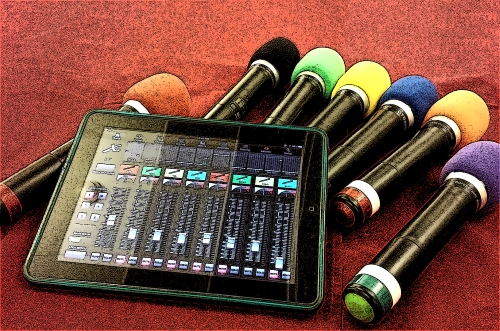The impending death of the 600MHz range for wireless systems isn’t to be ignore but wireless ranges aside, isn’t it time we look at wireless systems themselves?
Let’s get this out of the way, by 2020 we can no longer use wireless systems in the 600MHz range, specifically from 614MHz to 698MHz. But, there’s a funny little gap of space that wasn’t auctioned off, from 653 to 663MHz, called the duplex gap. Can that be used? Until 2020, yes, though you’ll fight with whitespaces devices in that gap. I consider the duplex gap unstable. And after 2020, we can’t use that space anyway.
There’s no fear about finding new space, no running for two tin cans and a piece of string. We’ve got room to work. Specifically, there are three areas of the frequency spectrum to use:
1. 179 – 216MHz
This is within the Very High Frequency (VHF) space, which actually starts at 49MHz and includes usage for television stations – those things that came before Netflix.
2. 480 – 600MHz
The 480-600 is in the Ultra High Frequency space noted as UHF, which runs from 300MHz to 3000MHz
3. 2.4 GHz
GHz stands for Giga Hertz, not Giga watts, Marty. One is for wireless devices and one is for time travel. Never confuse the two. Jokes aside, I wouldn’t touch the 2.4GHz band with a ten foot pole.
The problem with the 2.4GHz range is it’s also used for Wi-Fi. That means any device that’s used as a mobile hotspot or a church that offers free Wi-Fi is going to wreak havoc on a wireless system like a wireless microphone that uses the 2.4GHz range. I know techs who use microphones in the 2.4GHz range and they work great. So it’s up to you and a good RF scanner to see if it’s usable.
Moving on from frequency usage, there are several terms that come up with wireless systems and it’s good to understand these terms before making the next purchase.
Analog Systems versus Digital Systems
Digital systems offer a lot of additional functionality over analog systems, such as Dante-compatibility, but one noticeable difference is in how the signal goes from the wireless transmitter to the receiver.
An analog system compresses the audio at the transmitter point where it’s sent to the receiver, it’s expanded. This compression/expansion technology is called companding. A cheap compander will cause audio fidelity to be lost. This is one reason a cheap analog wireless microphone sounds cheap.
Higher priced systems use modern state-of-the-art companders that don’t have this fidelity loss. Digital wireless systems don’t use companders at all because they are sending a digital signal instead of an analog one. A top-notch analog system can sound just as good as a digital one.
Related to interference, when an analog system gets a little interference, you hear a little interference but you still hear the main audio. With a digital system, the signal can drop completely, so it either works or it doesn’t.
Diversity Circuitry
Receivers with diversity circuitry monitor more than one antenna (usually they have two) and will pull the better signal from between the two antenna. How often could a wireless receiver switch between antennas? I’ve seen them bounce back and forth every few seconds.
Frequency Agility
This is not the measurement of speed in which you change your car stereo when commercials come on. You know, that technology we used before music streaming and storing 4,000 albums on our smartphone. Frequency agility is the ability to pick the transmission frequency of the wireless system.
A basic system should provide a handful of predefined frequency channels, say ten. This might be labeled in the system as A, B, C, etc. or 1, 2, 3, etc. and in this case, the manufacturer has determined those frequencies.
An advanced system might include 20, 30, or 40+ pre-defined channels. This way, you could have up to forty or more clear channels of wireless without worry of intermodulation interference – interference caused by receivers detecting signals on transmission frequencies in close proximity to the intended transmission frequency.
From there, some systems allow for fine-tuning to a specific frequency like 547.25MHz. With all of the options available, if you’re completely new to wireless technology, you’ll be happy to know that many models have an auto-scan function which scans all of the available frequencies that model can use and picks the clearest one. If you get interference one day, just scan again.
Batteries
Wireless transmitters, such as the handheld microphone or the battery pack, can be powered by built-in rechargeable batteries that plug into a docking station, or with regular batteries.
This presents three options: built-in rechargeables, regular batteries, or rechargeable batteries. There are pros and cons to each though the biggest question I see is, “Is it ok to use rechargeable batteries with my existing wireless microphones and in-ear systems?” The answer is…debatable.
First, anything that uses a battery must be monitored because a battery can give out at any moment. The good news is every battery has a lifespan. In audio production, you quickly learn how many hours you can run your batteries until you need to swap in new ones. In my experience, I can easily run rechargeables or regular batteries for over four hours straight.
Some people say they only use regular batteries and throw them out when the event is over because in their experience, “rechargeables fail.” In twenty-some years of audio production, I’ve had two rechargeables fail on me and those batteries were near the end of their life. Rechargeables can be recharged thousands of times but eventually, several years later, they have difficult holding a charge. If you are going the rechargable route, don’t buy the cheap ones at the local big-box store, invest in high-quality Ansmann batteries.
The Microphone
All this talk about the wireless options and the type of microphone hasn’t been mentioned. Cardioid or omni-directional, dynamic or condenser, lavaliere or head-worn? There are many options and they all depend on your situation.
Where to Next?
Wireless microphone usage isn’t as simple as buying what’s affordable. It’s about buying the right microphone that gives the configuration options you need and produces the best sound given any budgetary restraints.
Don’t just buy what’s the least expensive or the most expensive. Do your research and buy what’s best for your situation.















